#susan calvin
Text
Hari Seldon and Lady Gladia, in the afterlife, on their way to meet Susan Calvin and tell her what they did with robots:
youtube
#isaac asimov#robot series#foundation series#susan calvin#hari seldon#gladia delmarre#lady gladia#Youtube
13 notes
·
View notes
Text
If you can tolerate wading through pre-1980s social mores in unexpected places, I'd advise reading the Susan Calvin short stories by Asimov, because I think a lot of you would appreciate her endless frustrating experience working for robot tech support.
"My robot broke one of the Three Laws" "Did you program them to break the Laws?" "Yes but only if our CEO tells them to" "SiGHHHHHhHH"
8 notes
·
View notes
Text
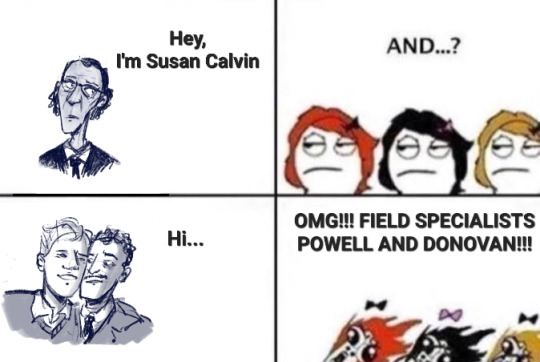
currently on "escape!" and they showed up!!! i missed my cursed engineers <3
art by @not-the-blue
#yes i made a 2012 i robot meme instead of sleeping or studying#i robot#isaac asimov#susan calvin#gregory powell#greg powell#mike donovan#escape!
25 notes
·
View notes
Text
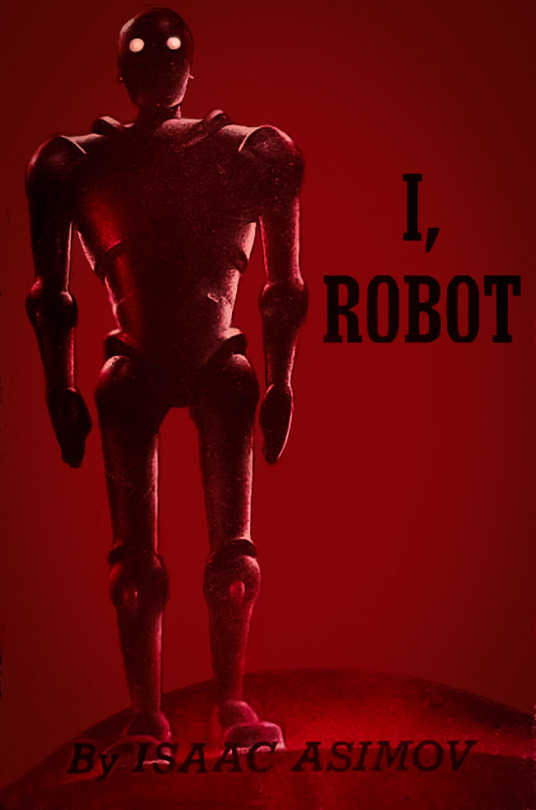
I, ROBOT by Isaac Asimov. (New York: Gnome, 1950). Cover by Edd Cartier.
Initial edition of 5,000 copies.
“Robbie" (Super Science Stories, September 1940 as “Strange Playfellow”, revised 1950)
"Runaround" (Astounding, March 1942) [Mike Donovan]
"Reason" (Astounding, September 1941) [Mike Donovan]
"Catch That Rabbit" (Astounding, April 1944) [Mike Donovan]
"Liar!" (Astounding, May 1941) [Susan Calvin]
"Little Lost Robot" (Astounding, March 1947) [Susan Calvin]
"Escape!" (Astounding, September 1945)
"Evidence" (Astounding, September 1946) [Susan Calvin]
"The Evitable Conflict" (Astounding, June 1950) [Susan Calvin]
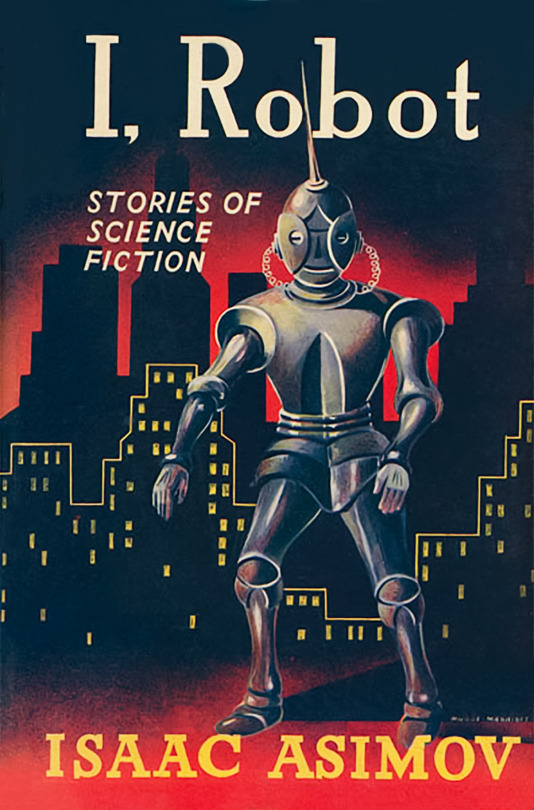
(London: Grayson & Grayson, 1952)
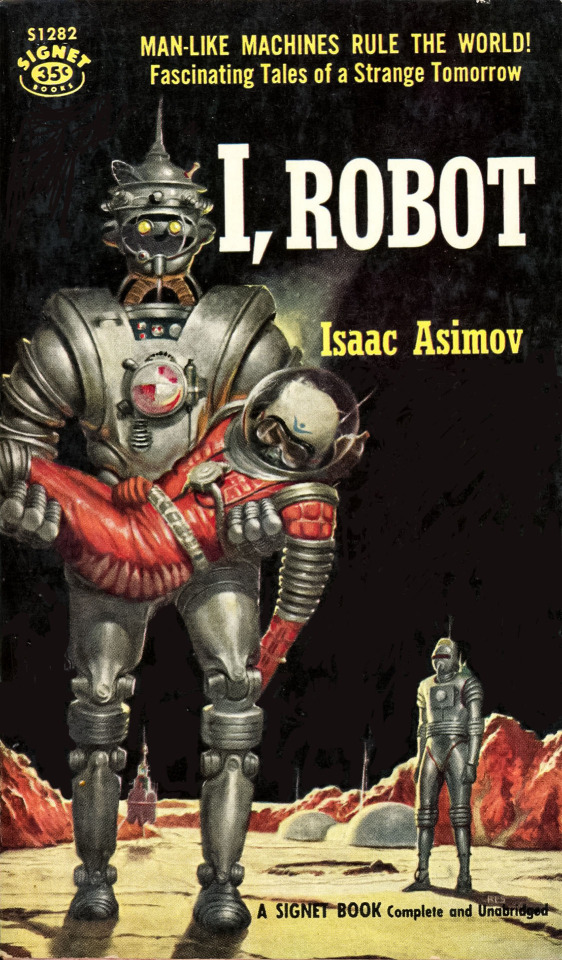
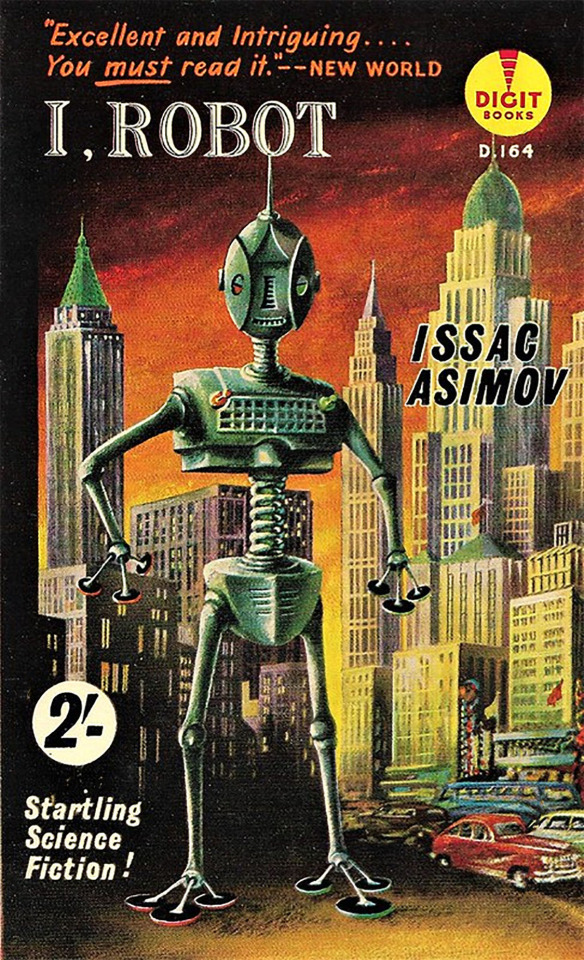
(New York: Signet, 1956)/(London: Digit, 1958)
#book blog#books#books books books#book cover#science fiction#science fantasy#i robot#isaac asimov#edd cartier#susan calvin#3 laws of robotics#astounding science fiction#ai#mike donovan#artificial intelligence
3 notes
·
View notes
Text
Susan Calvin, except for two hours of resentful lassitude, experienced nothing approaching sleep.
Isaac Asimov, I, Robot
#quote#quotation#Isaac Asimov#I Robot#Susan Calvin#resentful#lassitude#sleep#insomnia#oh we've all been there
4 notes
·
View notes
Text

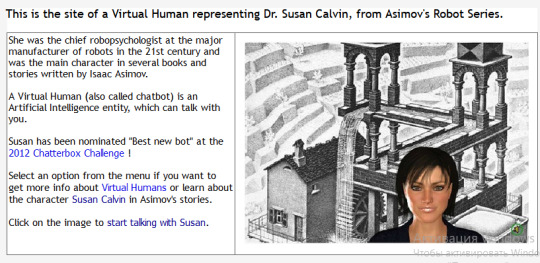

The sweet, sweet irony of this even existing is palpable. Like, imagine if Susan had to deal with a robot programmed to think it was the original Susan Calvin - or, better yet, imagine being that robot.
#also that render sure is... something#idk she might be described as having a pale face in canon but ever since childhood i hc-ed her as black#i robot#susan calvin
3 notes
·
View notes
Text
I feel like Susan Calvin isn't talked about enough, I personally love her a lot, too much even. I will NEVER shut up about how much I adore this specific character. I've seen few people hate on her and man no one was ever this wrong. I will FIGHT for Susan Calvin, sweat and blood. One bad word against her and it's on sight.
Btw did you guys know that Susan actually had a lover? Yes she did, it goes unnoticed often but it's true and that lover is right here because It's me lol. Tumblr user @r0botic and Susan Calvin from Isaac Asimov's stories are canonicaly married, I've always loved her and I'm ready to give her all my life savings.
I'm genuinely so mad because of how she was viewed and described by others, but well I shouldn't be angry not everyone has a good taste. I still don't understand how the hell can someone dislike her though, like what are you doing bro?? Who tf do you like if not Susan Calvin?? Are you okay?? No seriously, are you ill or something? I'd literally drop to my knees and beg Susan to give me 5 minutes so I can confess my undying love for her. Everyone is supposed to be like this and if you aren't, you are the problem here and should get it fixed.
#susan calvin#i robot#some call me insane and some call me woke#but nothing can change the fact that im completely right#Susan Calvin is THE woman everyone should bow down to
33 notes
·
View notes
Text
Little Lost Robot
A delightfully faithful adaptation of Little Lost Robot. I like this Susan Calvin, and the low-budget charm (a la Doctor Who or The Twilight Zone). Wish they had adapted more Robot shorts like this. I’d take this janky honest adaptation over any slickly bastardised and accursed one any time.
youtube
19 notes
·
View notes
Text
Susan Calvin
Susan Calvin (December 2, 1982-April 6, 2064) was an American engineer and psychologist best known for pioneering the field of robopsychology. Calvin was born Susan Derkins in Empire Bay, Massachusetts, where she spent much of her early childhood. Calvin—surprisingly given her later life–was a rather hotheaded child and prone to getting into conflict with neighboring kids, in particular a young Calvin Durden, whom would go on later in life to form Project Mayhem. In 1988, Calvin’s father Andrew Derkins passed away and her mother would remarry James Calvin in 1990, with the young Susan taking his surname. The Calvins would end up leaving Empire Bay in 1991 in favor of the Pacific Northwest, taking up residence in Arcadia Bay. Calvin cites the isolation she felt at being so thoroughly uprooted as a crucial component in her own upbringing and developing a fascination with various sciences, especially engineering and psychology. Her impressive high school grades allowed her to be offered admission to Columbia University at the age of 17, which she accepted and began attending in 1999.
As a student at Columbia University, Calvin initially focused on studying psychology. Unusually for a Columbia University psychology student, Calvin held a disdainful view of the field of parapsychology despite the roles of former Columbia professors John Montague and Peter Venkman in pioneering that field. Calvin instead was drawn to the ideas of noted skeptic Richard Strand, who held that most paranormal phenomena was illusory or scientific phenomena not properly explained yet. Calvin was interested in the psychology of violence and crime, attending both lectures given by FBI profiler Clarice Starling and initially planning to write her thesis on Johan Liebert. However, Calvin’s interests would shift towards robotics and cybernetics. She had always had a passing interest in the topic–even writing a peer-reviewed article at age 16 about the practical aspects of robotics–but she soon came to center this topic in her area of interest. One factor shaping this was the 1999 MegaTech incident where a number of robots whom had been used to replace teachers in high-crime school districts reverted to a militaristic programming that claimed hundreds of lives nationwide. Calvin was thus drawn to the idea of what the proper limits of robotics ought to be. She ended up writing as her thesis ‘Integration of Ethics in Artificial Intelligence’, where she cited the WOPR and Colossus incidents of 1983 and the 2001 Discovery 1 disaster to argue that as AI advances, it will become increasingly necessary to construct programming that binds them to a code of ethics, especially as it merges with the field of robotics.
In her last two years at Columbia, Calvin pursued both psychology and engineering degrees. She would intern briefly at Cyberdyne in 2001 before leaving owing to the belief that management was unwilling to consider the questions of what limits should be placed on robots. Calvin would pursue a graduate degree in cybernetics and psychology at Miskatonic University, completing her thesis which coined the term ‘robopsychology’ under Professor Velma Dinkley. She was subsequently hired by US Robotics and Mechanical Men, Incorporated, which was intrigued by her ideas of robopsychology. Despite her later reputation, it is worth noting that Dr. Calvin was largely considered a fringe figure among artificial intelligence researchers and robotics engineers in this era. Figures like Nathan Bateman and Robert Ford belittled Calvin’s view that these constraints were necessary, instead arguing no machine could fully match a human mind and that, as mechanical devices, they would always remain under human control. At this time, these concerns were still considered largely theoretical as robotics and AI proved slower to integrate into wider human life compared to the expectations of earlier eras.
Calvin’s application of psychology to robotics was not her only contribution to the former field, however. In 2008, following the debut of the synthetic blood substitute TruBlood, the world’s vampire population revealed their existence. Immediately, opinions were polarized-many human supremacist groups found themselves in uneasy alliances with organizations dedicated to controlling the supernatural like the Watcher’s Council and Hellsing claiming they were a danger to humanity but vampires themselves and a number of human sympathizers argued, diet aside, they were no different from humanity and deserved the same rights. Calvin approached vampires with an impressive level of objectivity, seeking to understand the psychology of vampires. She interviewed over 200 vampires in the process of compiling her 2011 paper The Psychology of Undeath: Inside the Minds of Vampires. Calvin broke vampire frames of mind into multiple categories. On one extreme, she identified what she called the reluctant. This category of vampires viewed what they were naturally predisposed to be with revulsion and sought to make up for it. She cited Vladimir Tod, Louis de Pointe du Lac and the Cullen family as examples of this category, seeking to stave off their hunger or satiate it in other ways even pre-TruBlood. On the other extreme she identified the ‘monster mindset’, which views vampirism as a gift and the predation on humanity as a feature rather than a bug. These vampires, Calvin said, would likely try to feed even with TruBlood being available. Most vampires, she argued, fell in between-the likes of Klaus Mikaelson, Laszlo Cravensworth and Michael Morbius having some degree of ethics and morality tempered, but not wholly eliminated by, the need to feed. Calvin dismissed claims that vampires were inherently soulless monsters as superstition but did acknowledge that most vampires have significantly reduced empathy compared to the average human-but argued at the closing such a thing was ‘a byproduct of natural selection for what is, at the end of the day, a predator of humanity by nature now given an off-ramp.’
Calvin’s work on vampire psychology thus concluded, she would resume a focus on robotics. She would work with Tak Mashido to design models of robots capable of engaging in boxing, which would nearly eliminate the industry altogether after one of their robots bested boxing champion Adonis Creed in a 2019 match. Calvin also helped develop blueprints for the Jaegers used by the Pan-Pacific Defense Corps, modeling them on the Japanese EVA units deployed against the ‘angels’ attacking Japan at the same time. Calvin would move to California in 2015 to pursue further consulting jobs. In addition to her ongoing robotics work, Calvin was paid by tech billionaire Peter Gregory to come up with a method for uploading a human brain into cyberspace as a way of achieving immortality and was one of the first members of Amaya’s quantum computer team and contributed heavily to the engineering behind their primary project. Calvin viewed these projects with interest, but was never especially passionate about most of her work, pursuing it with a clinical interest. It is likely for this reason her one romantic entanglement in this time was with the similarly clinical Paul Redeker, a political consultant infamous for past work for the apartheid regime in South Africa whom had subsequently worked for the US government to aid in postwar reconstruction of Iraq, Adjikastsn and Afghanistan. The relationship did not last long, as Redeker and Calvin lacked significant shared interests, but has been viewed as indicative of Calvin’s normal disposition. Calvin is also known as one of the leading critics of the creation of ‘Replicants,’ arguing their purpose could equally be filled by robots with the ability to ensure perfect programming being more possible on a machine than a human brain. Calvin was criticized by some for the clinical detachment involved in this criticism, which also included citing the actions of the Rossum Corporation and their failures as an argument against Replicants, though it is generally accepted Calvin couched her criticism this was as part of a broader belief expressing the depth of her true emotions on the topic would be useless.
One of Calvin’s most important consulting jobs, however, involved her work on the MULTIVAC network embedded in a wide range of technology, but notably a key part in voting machines launched starting in the 2012 election. This network not only would ultimately gain sentience, but was a key element leading to Calvin becoming a political target. During the 2020 presidential election, Republican nominee David Jefferson Adams claimed the MULTIVAC network would be used to rig the vote in favor of his Democratic opponent Jonathan Lincoln Duncan. After Duncan’s victory, Adams’ supporters continued to denounce this network and after the President’s Day Massacre of 2022, Adams’ Attorney General Michael Seaver would announce the designers of MULTIVAC, including Calvin, would be charged with electoral interference and treason. As the Adams administration was actively restricting and rolling back rights, Calvin was only allowed to use the legal services of Jimmy McGill, himself an inmate in New Mexico who was notorious for his role aiding various drug kingpins. However, in a blow to Seaver and Adams, McGill proved an adroit defense attorney and managed to help Calvin escape imprisonment. After getting off, Calvin was involved in anti-Adams activities, participating in protests against the disqualification of Democratic nominee Georgina Hobart from the 2024 election due to allegations of treason and using her professional network to help sabotage technology used in the Adams administration’s efforts to suppress the Gabriel Bell riots and Equisapiens attacks on facilities operated by the Adams aligned WorryFree corporation.
Calvin would rise to increased prominence following the Inauguration Day bombings and subsequent outbreak of the Second American Civil War. She was in California at the time, a region which quickly devolved into chaos as the conflict ignited. Originally, the state government under Governor Hobart declared itself independent. However, Hobart was ousted from power in a coup organized by a number of corporate leaders operating in Silicon Valley, led by the billionaire tech moguls Steve Lift and Peter Isherwall, who installed Zach Morris as Governor. The group’s goal was to bring California into the fold of the Allied States of America, a corporate-driven regime purged of the fundamentalism of Adam’s more fanatical backers. However, shortly after the ASA was formed, its attempt to strike the Greater Korean Republic, who it framed for the bombings, led to the GKR invading the West Coast, occupying a large swath of California. Moreover, the AI Skynet would unleash an army of Terminator units on the state, massacring thousands and imprisoning some in simulations intended to harvest their body heat to power itself. California’s resistance to the ASA, GKR and Skynet organized under the leadership of John Connor, who made Calvin a key member of his inner circle. Calvin helped develop a number of computer viruses that enabled the breakdown of Skynet’s ‘Matrix’ system and helped prevent a GKR advance to the Rocky Mountains. Connor’s Californian resistance group received aid from many other North American factions fighting the Second American Civil War, including the NAN, the United Canadian and American States (a coalition formed in Columbus by the leading claimant to the mantle of the old US and Canada’s government after losing Quebec, British Columbia and Alberta to secessionists) and even the theocratic Republic of Gilead that occupied much of the Deep South.
This unlikely coalition, aimed at the existential threat of Skynet and the GKR as well as the traitors heading the ASA, likely is what made the ceasefire and formation of the Organization of North American Nations in 2028 possible. Calvin, following this, would become a figure in the independent Californian government, working for President Connor as his leading technology advisor. Calvin helped negotiate terms for Japan to send a large amount of the technology dubbed the ‘Japanese Miracle’ to the badly-battered California, enabling rapid reconstruction of devastated cities in the state. Calvin also, in this capacity, developed a series of protocols all sentient machines manufactured in California were obligated to follow: the Three Laws of Robotics, which prevented robots from harming humans or allowing humans to come to harm, ordered preservation of human life except in conflict with the First Law and ordered robot self-preservation save for in instances conflicting with the first two laws. While eventually hailed as a groundbreaking framework, many technology firms scoffed at Calvin’s protocols. The ONAN’s Congress blocked an attempt by ONAN President Lisa Simpson to mandate the Three Laws in the whole ONAN and when Senator Andrew Steele Jarrett, an acolyte of Gilead’s Prophet Steve Jordan, won the 2032 ONAN election, he outright targeted Calvin both for these laws and her public scorn for the politics of Gilead Jarrett made an attempt to enforce nationally. When protests and riots forced Jarrett out in 2035 (sparked by a mix of his heavyhanded push for continent-wide theocracy and his poor handling of the Green Flu pandemic that ravaged his native Gilead and sparked the regime’s collapse to a large-scale revolt a few years later), his successor Elizabeth Winters halted efforts to target Calvin, but continued to resist making the Three Laws mandatory owing to her own efforts to weaponize robots. Opinion on the Three Laws, however, would turn drastically following the CyberLife android revolt in Detroit in 2038 and the rise of the city-state of Zero One in Qumar two years later. In the 2040 ONAN election, the independent ex-Republican Robert McAlistair, who ultimately won, openly endorsed the mandating of Three Laws compliance in all sentient machines, which came into effect in his first year as President.
Calvin continued to work as a psychologist of both humans and robots despite her general fame. In 2029, Calvin made her first visit offworld to Hyper Base, a facility set up on an asteroid by the ONAN military. At various times, Calvin was called in to evaluate US Robotics and Mechanical Men-manufactured robots experiencing malfunction, but also was consulted by a number of other companies and figures as well. The Kwan Do family, who ran Mars’ third largest settlement, hired her to evaluate their drones’ effectiveness and verify their compliance with the Three Laws. Calvin was also contacted by Metaverse Enterprise Solutions to investigate if a simulated character they had created had actually been deleted from existence or not. Calvin’s findings were officially inconclusive but rumors persist that she verified the character did in fact survive, but refused to disclose this information to her creators. The billionaire Cosmo Spacely hired Calvin to help design his ‘Levittowers’ that began cropping up in the 2050’s and 2060’s. Calvin was a prominent opponent of the ONAN’s adoption of the ‘Precrime’ system of predicting crimes before they happened and warned that it coupled with the rise of the ‘street judge’ system would end in the total elimination of civil liberties. Calvin’s role in the public eye would conclude in 2058, with her retirement. After giving a final interview covering thoughts on current events and technology, Calvin would remain a recluse until her death of natural causes in 2064. Calvin would leave a long-lasting legacy, as robotics manufacturing remained heavily influenced by her, though the lead-up to the Great War increased the number of Three Laws-violating robots in existence greatly.
References
Asimov’s Robots Series, Calvin and Hobbes, Fight Club, Life is Strange, Haunting of Hill House, Ghostbusters, Silence of the Lambs, Monster, Class of 1999, WarGames, Colossus: The Forbin Project, 2001: A Space Odyssey, Terminator, Cthulhu Mythos, Scooby Doo, Ex Machina, Westworld, True Blood, Buffy the Vampire Slayer, Hellsing, Chronicles of Vladimir Tod, Interview With a Vampire, Twilight, The Vampire Diaries, What We Do in the Shadows, Marvel Comics, Real Steel, Rocky, Pacific Rim, Neon Genesis Evangelion, Silicon Valley, Devs, World War Z, SOCOM: US Navy SEALS, Blade Runner, Dollhouse, Franchise, Shattered Union, The President is Missing, Growing Pains, Breaking Bad, Better Call Saul, The Politician, Star Trek, Sorry to Bother You, Jericho, Don’t Look Up, Saved by the Bell, Homefront, The Matrix, Shadowrun, The Handmaid’s Tale, Infinite Jest, Ghost in the Shell, The Simpsons, Parable of the Talents, Christian Nation, Left 4 Dead, Vanquish, Detroit: Become Human, The Animatrix, Jack and Bobby, Empire Earth, Doki Doki Literature Club Plus!, The Jetsons, Minority Report, Judge Dredd, Fallout
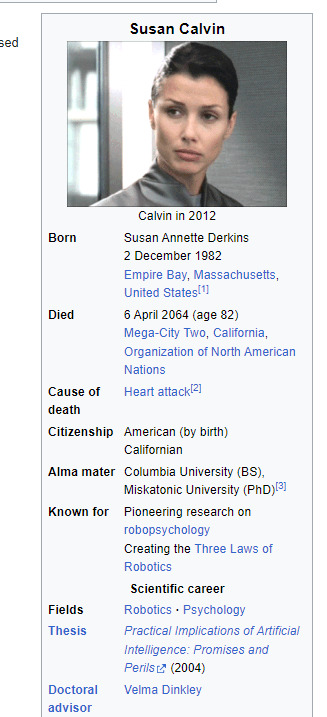
#mega crossover#I robot#robots#terminator#the handmaid's tale#future history#three laws of robotics#Susan Calvin#alternate history#wikibox
8 notes
·
View notes
Text
Genuinely love that Asimov is like, Susan Calvin is an UNATTRACTIVE MIDDLE-AGED woman with a HEART OF STONE whose only redeeming characteristic is her BRAIN. like honestly I love scientists that are smart and hot but sometimes also I love scientists that are smart instead of being hot.
6 notes
·
View notes
Text
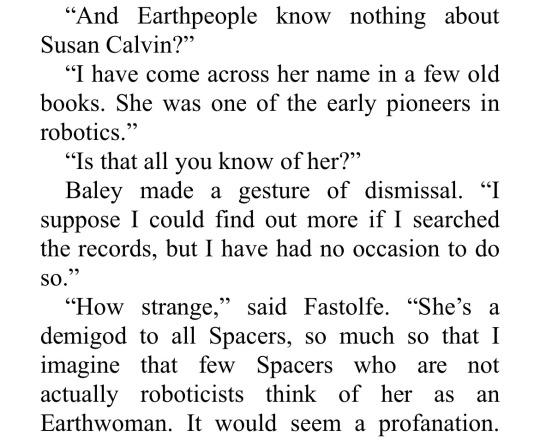

#susan calvin#being remembered a thousand years into the future#the robots of dawn#isaac asimov#asimov robot series#reading challenge 2023
5 notes
·
View notes
Text
Susan Calvin would be so concerned about what the robots are doing in Foundation and Second Empire
Or would she
3 notes
·
View notes
Note
any top asimov headcanons?
SO! MANY!
Elijah had a serious boyfriend in college. It was his last serious relationship before Jessie.
Speaking of Jessie, her political career briefly mentioned in Mirror Image flourished. She's got a great way with politics, which, incidentally, is indirectly the reason why Baleyworld was a success. Elijah is a political disaster, the colony worked thanks to Bentley, and he inherited all of his political ability from his mother.
She also found someone better suited to her after she and Elijah separated.
Daneel unconsciously programmed Dors while thinking of Elijah, which is why she's so impulsive and comes across as such a good mixture of the two of them. She's totally their daughter.
To protect Dors from roblock, Daneel programmed her not only with the Zeroth Law, but he managed to invert the Second and the Third Laws, so that she feels a higher instinct to protect herself than other robots do. He did this because he was traumatized from losing Jander and Giskard to roblock.
Elijah stims. Check out my fic about it!
Elijah was a very romantic and imaginative child, but his hard life and the restrictiveness of the City made him try hard to fit in, and he didn't recover that part of himself until he met Daneel.
Raych's charisma is a weaker form of phychic power. Wanda inherited it from him, her powers are just much stronger.
Hari already wears glasses in his youth.
Yugo Amaryl is definitely autistic.
Lucky Starr's canonical two dads are a couple. Perhaps they were in a poly relationship with his bio parents.
Stephen Byerley adopted Lenny after Susan Calvin died.
Based on the fact that Asimov hoped while alive that his last words would be "I love you, Janet", that Janet says that they were indeed, and that he had a tendency to write characters dying saying the name of the person they loved ("Little Miss" "Dors!"), and the fact that Elijah and Giskard had the exact same last words, maybe Giskard was also in love with Daneel.
If Asimov had lived to write one more book in the series, Daneel would have finally died, and his last words would have been "Partner Elijah."
The Robots/Empire/Foundation verse is set in the timeline Noys created in The End of Eternity.
#Asimov#Isaac Asimov#Robot Series#I Robot#Foundation series#Elijah Baley#Daneel Olivaw#C/Fe#Dors Venabili#Hari Seldon#Raych Seldon#Wanda Seldon#Susan Calvin#Lucky Starr
13 notes
·
View notes
Text
*panting while desperately searching for I,robot enjoyers*
5 notes
·
View notes
Text
On the Subject of Susan
I'm going to be a little blunt and my words may seem antagonistic here. But no hate, please. I'm just trying to analyze and provide my analysis based on the very simple facts. Now.
I've never quite understood the anger at C. S. Lewis for how he ended Susan's tale. Mainly, I suppose, because I had the whole story.
Everyone gets angry that Susan is "banned from Narnia" because she likes lipstick and nylon stockings and being a teenage girl in the 1940s, but no one seems to understand that that's not quite how it went, much less that Susan still has a chance.
Let me work backwards a moment and explain the latter. You see, to quote Lewis himself, in a letter to a girl called Marcela in 1955,
"...Haven’t you noticed in the two you have read that she is rather fond of being too grownup? I am sorry to say that side of her got stronger and she forgot about Narnia... ...She is left alive in this world at the end, having been turned into a rather silly, conceited young woman. But there is plenty of time for her to mend, and perhaps she will get to Aslan’s country in the end—in her own way. I think that whatever she had seen in Narnia she could (if she was the sort that wanted to) persuade herself, as she grew up, that it was ‘all nonsense’”
Now, there's a lot to unpack here, but first and foremost, my point is quite simple. "Perhaps she will get to Aslan's country in the end-in her own way." It was always meant to be open ended, for Susan. Narnia is not forever closed to her, unless you and she choose so.
"But Peace!" I can hear you saying, "There's that whole 'too fond of being grownup' phrase!" Why yes, yes there is, how clever of you to notice. The whole point of the latter portion of Susan's arc is that she chose that- lipstick and nylons and "being grownup"- over Narnia. She grew and she chose to forget Narnia.
After all, what sort of modern teenage girl (in England, during WW2) would be so interested in medieval times and what they probably explained to their friends to be a good old game of pretend? No, no, she can't remember Narnia right now - she's going to the cinema with a few girl friends, she's going to a party, she's focusing on everything but there and inevitably, after pushing it away for so long, Narnia let her be.
You see, C. S. Lewis was a very Arminian (and yes, I spelled it correctly) Christian theologian. And while I'm sure most of you here on this hellsite would like to ignore that, it is relevant to how Lewis wrote his fiction. After all, it's at the core of his basic beliefs, despite his being a staunch atheist in college and into his adulthood, and despite what you may like to think, it crept into his writing even when he did not intend it. For example, The Lion, the Witch, and the Wardrobe is called an allegory for the story of the Resurrection, despite Lewis' arguments to the contrary. He insisted that it be seen as what it is, very heavy symbolism. Very heavily used Christian symbolism, that is all over the Chronicles whether you like it or not.
Let me explain why this is relevant to Susan, what Arminianism even is, and how that term applies here. Susan is, so to speak, a symbol of an atheist left behind, after all of the Christians she called family died. In a situation where you regard Christianity as true, she is left on Earth while they have gone on to heaven. And this doesn't mean that the gates of heaven are closed to her, quite to the contrary! They would be closed on the day she died insisting that Jesus Christ was not Lord, plain and simple. She has a choice to make, so long as she is alive.
Now, to Calvinist theologians and Christians, Susan never had a choice. Either Aslan, the God symbol here, chose to bring her in, or he didn't. Calvinists believe in a thing called predestination, the concept that every believer that would ever be brought to heaven is chosen specifically by God. Arminianism declares the opposite. It's a whole thing in Christian theological circles, but that's irrelevant to this discussion. In any case, the core of Arminianism is that you and I have a choice in whether or not we believe in God, and in whether or not we go to heaven.
To an Arminian theologian, God, or Aslan in this symbolic case, can influence our choice, Susan's choice, up to a point. Once we reach that point, once Susan forgets, God, or Aslan, steps back. He accepts our choice, allows Susan to forget. It's up to us, up to Susan after that.
Lewis was an Arminian theologian. He made the point, repeatedly, in his theological works, about people having a choice.
He repeats that point with Susan.
One last thing, before you go. You see, there was another letter about Susan, after The Last Battle was released. He'd been asked if he ever intended to finish Susan's story.
This was his answer.
“I could not write that story myself. Not that I have no hope of Susan’s ever getting to Aslan’s country; but because I have a feeling that the story of her journey would be longer and more like a grown-up novel than I wanted to write. But I may be mistaken. Why not try it yourself?”
Well, my people? Now that you've heard what I had to say (and say through quite the essay, my apologies), why not? Go, do what you do and tell her story for yourself. The author has encouraged fanfiction, so go on! And don't worry about Christianity and symbolism too much. It may help you understand how and why Lewis wrote what he did, but unless you're determined to have your tale in his style and overlapping seamlessly with canon, it's unnecessary. Unless you choose to make it a part of your life, you don't have to be concerned about it.
Feel free to ask questions, and I'll answer to the best of my ability, with Google by my side!
Also, I nearly forgot. There are absolutely other problems with Susan being the last of her family, left alone in the aftermath of WW2. This is not the place to talk about those, however, merely to help you understand why she "is no longer a friend of Narnia" and to remind you that there's always hope.
Oh, and besides that, don't forget that I'm talking about the books and not the movies thank you very much, while The Lion, the Witch, and the Wardrobe was absolutely perfect to canon the other two were not and I'm not going to consider them in this post. I do appreciate them, but when dealing with book canon they're both nos.
#susan pevensie#the chronicles of narnia#the problem of susan#narnia#narnia susan#well this wasn't my plan for 3 am but here we are#arminianism#calvinism#my theology is very arminian leaning#but i tried to depict the two sides fairly#or as fairly as i can at 2 in the morning#if you want to know#im arminian with a touch of predestination#i believe that you get a choice#but also that sometimes#like with paul#god will smack you upside the face with undeniable proof of his existence#even then denial is an option#just not denial of his existence anymore more denial of his sovereignty
56 notes
·
View notes
Text
Botanic Tournament : Susans Bracket !
Round 2 Poll 2


#botanic tournament#tournament polls#susans bracket#round 2#susie derkins#calvin and hobbes#calvin & hobbes#c&h#susan sto helit#susan death#discworld tag#discworld#terry pratchett
68 notes
·
View notes